FUNERALS IN JAPAN
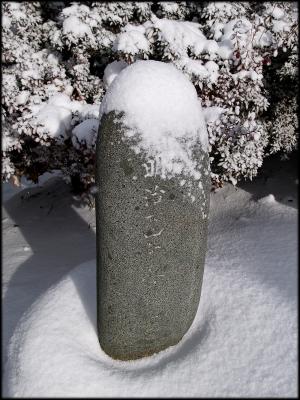
Japanese tombstone There are about 900,000 deaths a year in Japan. In Japan, 99.4 percent of people are cremated, the highest percentage in the world, compared to 30 percent in the United States and 53 percent in China.
According to the Justice Ministry’s Civil Affairs Bureau, when a person dies, a relative, landlord or another person concerned is required to submit a death notification form obtained at a municipal office as well as a document, such as death certificate issued by a doctor, to the relevant municipal government within seven days when they become aware of the person’s death. Following submission of these documents the death is registered in the family registry.
The death notification form is submitted before a crematorium permit is issued. After the cremation the permit is returned to relatives and then submitted to a cemetery when the ashes of the deceased are interred in a tomb.
Good Websites and Sources: Japanese Funeral Style 1 osoushiki-plaza.com ;Japanese Buddhist Funeral Traditions tanutech.com ;Academic Article on a Funeral in Sapporo jpri.org/publications ; Good 2009 Japan Times Article japantimes.co.jp ; Book: Funeral Industry in Japan Stanford University Press ; Blog Report anthropology.suite101.com ; Human Mortality Database mortality.org ; Cemetery Photos at Japan-Photo Archive japan-photo.de
Cremations in Japan
Driven by limited space and government nudging, the percentage of Japanese who are cremated has grown steadily, reaching 99 percent in 2009.
Cremation is considered a purification rite before the next life. Some people interviewed by Japanese news media after the earthquake and tsunami in 2011 said they faced a life of despair if they didn't find their relatives' bodies. Others fear their loved ones' spirits will haunt them without a proper burial. "Indeed, some people believe ghosts of the dead killed violently that are not cared for can cause problems," Ian Reader, professor of Japanese studies at Britain's University of Manchester, told the Los Angeles Times. "And places like Tohoku, with an aged population and a more 'traditional' orientation than, say, Tokyo, might hold to such views more strongly." [Source: Mark Magnier, Los Angeles Times, March 22, 2011]
Cremation requires 10 or more gallons of kerosene. After the earthquake and tsunami in 2011 kerosene was in short supply, and some local governments started burying the dead, an option some consider unclean. Priest Keizan Ishigamori told the Los Angeles Times, "Being buried or burned isn't about religion. It's more about culture and ceremony. The soul starts its voyage either way."
See Tsunami
High Funeral Costs in Japan
The average cost of a funeral in Japan is around $23,000, the highest in the world, three times higher than United States and 10 times higher than in Britain. About $6,400 is paid to a Buddhist temple in funeral fees. About two thirds of this goes towards a posthumous name. Costs are also high for dinners and presents given on the seventh day, 49th day, one year anniversary and two year anniversary after death. Land costs make anything other than cremation prohibitively expensive.
More than 60 percent of the $14,200 spent in a typical Buddhist-style service goes so the funeral company that works out details like the coffin and the hearse. The cost for a temple and priest is around $5,500 and food and drink for the wake and service, $4,000.
Families have traditionally not wanted to have a hand in the funeral arrangements because they regarded it as bad luck. These days more families are taking a more active role in the funerals. Some families have dropped the religious ceremonies and instead focused on art or music and individualizing the events toward the interests of the deceased.
Burden of High Funeral Costs
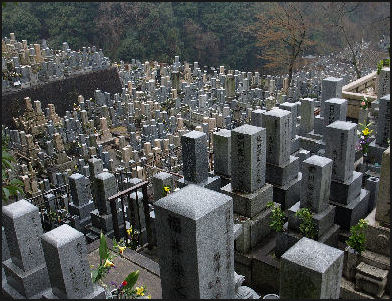
Kyoto cemetary Funerals are so expensive they sometimes put a large burden on bereaved families, especially those who leave everything to the funeral companies and are given a whopping bill when the whole ordeal is over. In a few cases customers have been so outraged by the high costs they sued the funeral companies for overcharging them.
The high costs of funerals in Japan give a lot of people stress. In recent years there has been a trend for bereaved families to take a harder look at the money side of funerals. Families are advised to get the cost up front and get estimates from several companies and not put their trust totally in the hands of one funeral company. Some companies such as Eopoch Japan Co. have responded to the trend by offering specially priced funeral packages that go for $4,000, $6,000 and $10,000.
One Buddhist monk in the Tokyo area has set up a dial-a-monk service that has 45 monks from seven schools on call that can deliver a variety of services at considerably cheaper prices than those offered by funeral homes or Buddhist and temples. Their service including chanting at wakes for ¥42,000, funeral services for ¥84,000 and posthumous Buddhist naming ranging from ¥31,500 to ¥157,500 and monk visits on seventh day, 49th day, one year anniversary and two years year anniversary after death for ¥130,000.
Buddhist Funerals in Japan
After a Japanese person dies he or she is usually honored with a Buddhist funeral, cremated and buried.
Funerals are held in Buddhist temples or at the Japanese equivalent of a funeral home, a complex with a crematorium and a meeting hall with a traditional wooden edifice where the body is laid in state. Details of the funeral service vary somewhat in accordance with the Buddhist sect that oversees the service. In a typical funeral hall service Buddhist monks chant sutras before a wooden altar adorned with rows of chrysanthemums and other flowers.
Its is ironic that most funeral services are Buddhist because Buddhism in its original form did not place much importance on such matters. The Japanese religious scholar Sachiya Hiro told the Daily Yomiuri, “Today’s funerals are actually shaped by Shintoism. Buddhism doesn’t have a conventional role in funerals. Buddhist thinking follows that whatever happens after death happens and people after they die should be left alone.”
Buddhism did not play a big part in funeral services until the Edo Period (1603-1867) when the shogun forced all people to register as Buddhists as part of an effort to eliminate Christianity to counter an upsurge in religion’s popularity. Before the Edo period must funerals were conducted in accordance with Shinto traditions. Under the shogunate, all families were required to register with a Buddhist temple and have that temple take care of rituals for the dead. People that didn’t go alone with the scheme were assumed to be Christian. The Buddhist monks put in charge of funerals in many cases had never carried out a funeral ritual before so they simply copied Shinto rituals or used rituals — such as creating posthumous names for the afterlife — performed for their fellow monks.
After World War II the monks were striped of their land holdings and turned to funerals as their primary source of income. That and tourism have helped temples stay alive.
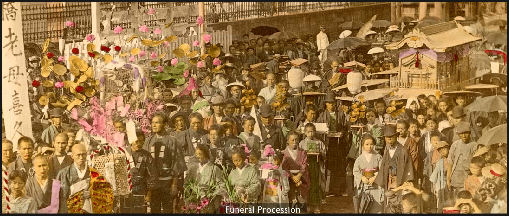
19th century funeral procession
Buddhist Funeral Customs in Japan
After someone dies a notice of mourning is written on white paper inside a black frame. It is placed on the door or gate of the house of the deceased throughout the mourning period.
According the Buddhist customs of “otsuya” (a sort of Buddhist wake) family members stay in the same room with the body of the deceased on the night before the funeral. Often they don't sleep the whole night and party and mourn and light incense sticks for the deceased throughout the night and finish with a meal of meatless dishes and sake. These days many people observe a half-“otsuya” that begins around 6:00pm and ends at 10:00pm.
At Japanese funerals, one is expected to wear black from head to foot with no shiny ornaments such metal buttons or belt buckles and jewelry, with an exception made for pearls. During the funeral the eldest son or some other senior family member wears a white kimono; other male mourners wear black suits, white shirts, and ties; and women mourners wear black dresses. The outfits are often rented and many mourners wear black arm bands.
The casket is a plain pine box covered with beautiful cloth. On top of casket are small vertical tablets with Chinese characters that spell out the name of the deceased and are believed to preserve his or her memory.
Mourners bring "condolence money" in white enveloped tied with silver and white strings. The amount depends on closeness to the deceased. Relatives usually give $200 or more. Acquaintances and friends give between $50 and $100. The money helps pay for the funeral. In custom similar to what takes place a wedding, guests are later given a thank you gift..
Traditional Japanese hearses are designed to look like portable shrines and mechanical floats. Some are decorated with engravings, gold bas-reliefs and images of pagodas, dragons and flowers and often have a roof covered with gold leaf. Over the years these have been replaced by American-style hearses.
Sometimes family members take a purification bath, a custom that Japanese have observed for some time. A Chinese visitor to 8th century Japan wrote: “When funeral ceremonies are over, all members of the family go into the water together to cleanse themselves in a bath of purification.”
Buddhist Funeral Service in Japan
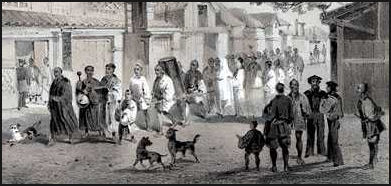
Western view of 19th century
Japanese funeral procession When the mourners arrive at the funeral service they bow to each other, saving their deepest bow for the senior family member in the white kimono. They enter a small room, sign a register, leave a name card and envelope with a cash offering and place a stick of lighted incense next to a picture of the deceased. [Source: Cindy Atoji, Washington Post, January 27, 1997]
The photograph of the deceased is draped in black and set on an altar in the front of the room. Around the picture are lanterns, and elegantly carved wooden bowls filled with offerings of fruit intended to feed the deceased on his or her journey to the next world. Above the alter is a scroll with an image of Buddha.
Close family members sit near the altar. Other mourners are further back. During the service mourners sit on tatami mats and listen to sutras recited by Buddhist monks and speeches about the deceased by family members and friends. Incense sticks are burned before the altar by the mourners and the priest recites sutras over the body. The caskets is then placed in the hearse and driven to the crematorium. At the crematorium family members often look on as the body is placed in the ovens and examine the ashes and fragments of bone when it is over.
These days more and more Japanese are eschewing traditional Buddhist funerals and instead are choosing a funerals that fits their personal tastes.
Buddhist Graves in Japan
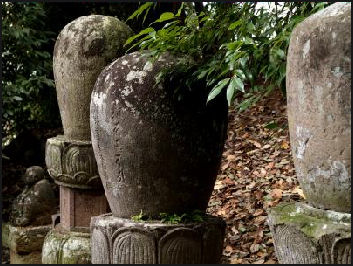
Later the canister or white box with the ashes is placed in a grave in a place where family members have been buried for generations. Families make regular visits to the graves, particularly during certain holidays. Some people visit family graves in a somber mood and bow and pray. For others it jovial occasions with friends and relatives, treating the deceased as if they were still alive.
The family often spends several thousand dollars to get a Buddhist name of the deceased and have a tablet places with this name inside a Buddhist temple.
Japanese graveyards contain rows of small tower-like tombstones, often jammed between houses and apartment buildings. Offerings left at graves include flowers, incense and sake as well as the favorite foods, drinks and even brand of cigarettes of the deceased. The sake is often poured in a glass and cigarettes are removed from the packs and lit so they can be consumed at that moment.
A grave site in an urban area often costs between $20,000 and $40,000. Traditionally, the oldest son’s family inherits the responsibility of taking care of a tomb with wife being responsible for her husband’s family tomb. Families with only female children must burden their daughters with the chore of taking care of two tombs.
Alternative Graves in Japan
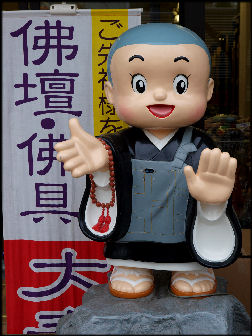
The shortage of space and the high price of land, funerals and memorial services has lead many Japanese to consider alternatives to traditional burials. More and more people are scattering the ashes of deceased relatives on Mt. Fuji or in the sea, a practice was considered unacceptable until the early 1990s.
Cybergraves, with offerings only a mouse click away, are becoming more common. There is also some discussion about offering rent-tombs, where a deceased person would be allowed to occupy a grave for certain amount of time, after which the ashes would be moved or scattered, and the grave would be occupied by someone else
Natural burial grounds are becoming increasingly popular. They are cemeteries on hill slopes and near forests. Users at one such place at a Buddhist temple outside Tokyo buy a 4.5 square meter plot for the ashes and use a tombstone that measures 18-x-18-centimeters.
Many Japanese want their favorite pet to buried next to them. Several dozens of Japanese have had their ashes blasted into space in “space burials” provided by New-York-based Celestis Inc, which says only Americans have more space burials than the Japanese.
For $1,500 one can get a 30-year membership to the Cyberstone Service by Kudokuin Temple in Tokyo which features video and pictures of a deceased loved one that can be accessed with a cell phone or computer.
In December 2010, a “business hotel for the dead” opened in Tokyo. Used to temporarily house bodies until funerals have been arranged, the three-story facility has 550 square meters of floor space and can hold a maximum of 37 bodies, Bodies are identified with bar codes to avoid mix ups and the rooms are equipped with anti-bacterial lights. The cost of housing the bodies is about $80 a night. The facility was set up in part to give families some time to think over funeral arrangements and not be rushed into making decisions because they have no place to store the body.
Beliefs About Death in Japan, Wives and Body Wholeness
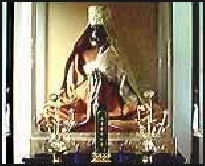
dead monk A survey by the Yomiuri Shimbun asked Japanese what they think will happens to them after they die. Thirty percent said they believed they would be reincarnated, 24 percent said they would go to another world; and 18 percent said they would vanish.
Many Asians believe that the soul and the body are linked together. They are reluctant to allow the corneas, heart and other organs of the deceased to be used in transplant operations because they believe that lost limbs and organs will "defile" the body and not accompany it to the next world.
Women are usually buried with their husbands ancestors rather than their own ancestors. The belief is that when a woman gets married she forsakes her own ancestors and becomes linked with those of her husband.
An increasing number of people are donating their bodies to medical schools after they die. Medical school use to have problems securing enough bodies for students but now there is an oversupply. The increase is believed to be attributed to changing ideas about death. A person in charge of body donations at Chiba University told the Yomiuri Shimbin, “Most applicants are in their 60s or 70s and the decision to donate his or her body is usually based on a wish to do something to help society.”
Remembering the Dead in Japan

After a Buddhist funeral, the priest gives the deceased a posthumous name, which is written on a small flat stick that is deposited in the family Buddhist altar. Prayers are offered daily before this altar. After approximately 33 years the stick with the deceased's posthumous name is burned. Thereafter the deceased receives worship only together with other ancestors. These rites move the deceased from the world of the living into the spiritual world and the status of an ancestor. The spirits of the dead are believed to return to this world during the festival of Bon, usually in mid August . [Source: Gary Ebersole, Worldmark Encyclopedia of Religious Practices, Thomson Gale, 2006]
Buddhist memorial services presided over by monks are held on the seventh day, 49th day, one year anniversary, two year anniversary and seven year anniversary after death. The services are usually held at the home of the deceased or close family member with a monk chanting sutras in front of a flower-covered altar. Afterwards participants share a large meal together. The 49th day is significant because Japanese believe that the spirit lingers in the body for 49 days before departing. This is in when the soul goes on a 49-day journey through the land of the dead and is judged and assigned where it is h going to go in the six realms of Buddhist cosmology.
A major memorial service with a large meal at a restaurant is held one year after the funeral. A Presents are given to guests. They in turn offer some money to defer the expenses. Then a another gift is given by the host. Memorial services continue for up to 33 years after the death. These are regarded as necessary to guide the soul to paradise. After 33 years the spirits loses its individual identity and fuses with ancestor spirits. For a flat fee of around $7,500 some Buddhist priests will provide all the services for up to 33 years.
See Buddhism, Death and Ancestor Worship in Japan Under BUDDHISM IN JAPAN factsanddetails.com
Bon Festival of the Dead in Japan
null “ Obon” (Festival of the Dead) in August is when the souls of the dead are believed to return to their homes. Many people visit the graves of the ancestors and set up lanterns to guide the spirits of ancestral souls to and from their homes. Many Japanese seem to feel that more people die in August than any other time of the year. Sometimes there are tie-ins with events that remember the dead form the bombings of Hiroshima and Nagasaki and the ed of World War II which also occurred in August.
According to Japan's Foreign Ministry: Bon Bon or Obon is an annual observance to welcome and console the souls of one’s ancestors, who are thought to visit one’s home at this time of the year. It was traditionally observed around the middle of the seventh month according to the lunar calendar. At present it is observed in most places between July 13 and 15, though in some regions between August 13 and 15. On July 13, welcoming fires (“mukaebi”) are lit to greet the ancestors’ spirits. Then, on the sixteenth, seeing-off fires (“okuribi”) are lit as the ancestral souls return to the spirit world. During Bon, many companies and stores close for vacation and since people who work away from their native places often return there with their wives or husbands and children, transportation facilities, as during Golden Week, become very congested.
See TRADITIONAL HOLIDAYS IN JAPAN factsanddetails.com
Image Sources: Ray Kinnane, Visualizing Culture, MIT Education, Jun at Goods from Japan, Japanese references
Text Sources: New York Times, Washington Post, Los Angeles Times, Daily Yomiuri, Times of London, Japan National Tourist Organization (JNTO), National Geographic, The New Yorker, Time, Newsweek, Reuters, AP, Lonely Planet Guides, Compton’s Encyclopedia and various books and other publications.
Last updated January 2024
